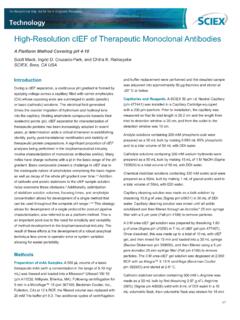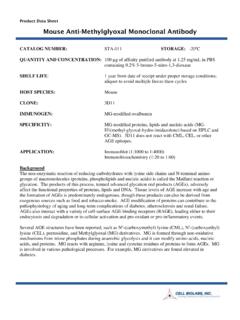Transcription of The novel therapeutic monoclonal antibody VGX …
1 The novel therapeutic monoclonal antibody VGX-100 neutralises VEGF-C and inhibits tumor growth and metastasis in subcutaneous and orthotopic models of human cancer. Baldwin, , Tester, A., Phelan, D. and Klupacs, R. Circadian Technologies Limited, Level 1, 10 Wallace Ave, Toorak, 3142, Victoria, Australia. Email: Abstract Introduction Materials and Methods Orthotopic Metastatic ProstateTumor Model Conclusions Subcutaneous Tumor Models Angiogenesis and lymphangiogenesis are important processes facilitating tumor growth and metastasis.
2 Growth factors that stimulate blood and lymphatic proliferation within tumors are therefore potential targets for anti-cancer therapies. Proof of concept of the clinical utility of anti-angiogenic drugs was first established by the FDA/EMEA-approved drug bevacizumab (Avastin ) which blocks VEGF binding to its receptors VEGFR-1 and VEGFR-2, the latter being the key receptor signaling for angiogenesis. However, patients treated with bevacizumab may be refractory or develop resistance to bevacizumab, suggesting upregulation of alternative pro-angiogenic proteins that allow tumors to bypass the inhibition of VEGF signaling.
3 VEGF-C is a logical candidate for inducing resistance to bevacizumab via this mechanism since it is also a ligand for the angiogenic receptor VEGFR-2 and for VEGFR-3 which is upregulated on tumor-associated vascular endothelium. VGX-100 is a highly specific, fully human monoclonal antibody for VEGF-C that blocks VEGF-C binding to both VEGFR-2 and VEGFR-3. Here we demonstrate that VGX-100 has an additive effect in combination with docetaxel and/or anti-VEGF (bevacizumab) in several tumor models, suggesting that VEGF-C may be an important mediator of the resistance to existing anti-VEGF therapies.
4 Further, we demonstrate that in an orthotopic model of prostate cancer, that inhibition of VEGF-C alone by VGX-100 monotherapy is sufficient to inhibit tumor growth and significantly reduce the incidence of tumor metastasis to local lymph nodes. These data indicate that VGX-100 has exciting potential as a cancer therapeutic by targeting a key factor involved in angiogenesis, lymphangiogenesis and tumor metastasis and is expected to complement chemotherapy and/or other anti-angiogenic compounds in the clinic.
5 The various VEGF ligands have distinct receptor binding specificities which contribute to their diversity of function, as summarized in Figure 1. VEGF-C and VEGF-D are ligands for VEGFR-2, which signals for angiogenesis, and VEGFR-3 which mediates lymphangiogenesis and tumour-associated angiogenesis. The receptor binding specificity of VEGF-C and VEGF-D is distinct to that of VEGF, which binds VEGFR-2 but not VEGFR-3. Recent publications suggest that in certain contexts, VEGF-C and VEGF-D, the alternative ligands to VEGF for VEGFR-2, can be up-regulated during VEGF blockade1,2,3,4,5.
6 Furthermore, in some mouse tumor models, administration of small molecule inhibitors of the VEGFR tyrosine kinase activity can increase subsequent tumor invasion and metastasis6,7,8. VEGF-C and VEGF-D up-regulation during VEGF/VEGFR suppression may be a key driver of resistance to anti-VEGF/VEGFR therapies. Expression of VEGF-C is elevated in a diverse range of tumors, including cancers of the colon, stomach, breast, ovary and prostate. Elevated levels of intra-tumoral and circulating VEGF-C frequently correlate with poor prognosis and features associated with tumor aggression ( tumor depth, size, lymphatic invasion and lymph node metastasis).
7 VGX-100 is a highly specific, fully human monoclonal antibody that neutralizes binding of VEGF-C to VEGFR-2 and VEGFR-3. Therefore, VGX-100 has the potential to inhibit not only primary tumor growth through its anti-angiogenic and anti-lymphangiogenic activities, but to also inhibit metastasis via the lymphatic vessels. Lymphatic metastasis is associated with poor prognosis that is not effectively blocked by anti-VEGF-A or anti-VEGFR-2 therapeutics. We have previously reported that VGX-100 inhibits primary tumor growth as a single-agent in human pancreatic KP4 tumor xenografts, and has anti-tumor activity in combination with bevacizumab in human U87MG glioblastoma tumor xenografts.
8 Furthermore, in the PC-3 prostate tumor model, VGX-100 significantly enhances the anti-tumor efficacy of docetaxel, and docetaxel + bevacizumab combination therapy. Here we further demonstrate, in mouse models of human lung (H292) and ovarian (OVCAR-8) cancer, that addition of VGX-100 to chemotherapy and chemotherapy + anti-VEGF (bevacizumab) enhances efficacy and prevents the development of escape mechanisms resulting in more durable responses Furthermore, inhibition of VEGF-C significantly inhibited both primary tumor growth and metastasis of orthotopic PC-3 prostate tumors.
9 Figure 1. Receptor binding specificity of the VEGF family. , A. et al., Clin Cancer Res., 17(2):372-81, 2011. , F. et al., British J Cancer, 1-8, 2011. , S. et al., J Neurooncol., Feb 11 2011. , F. et al., Nature Biotechnol., 25(8):911-20, 2007. , B. et al., Clin. Canc. Res., 1:12(5):1525-32, 2006. , J et al., Cancer Cell, 15(3):232-9, 2009. M., Cancer Cell, 15(3): 220-31, 2009. , S., Cancer Cell, 15(3): 167-170, 2009. 1020304050607080901001101201300500100015 002000 Isotype ControlDocetaxelBevacizumab + DocetaxelVGX-100 + Bevacizumab + DocetaxelDay Post-ImplantMean Tumor Burden (mg) +/- SE10203040500500100015002000 Isotype ControlBevacizumabVGX-100 DocetaxelBevacizumab + DocetaxelVGX-100 + BevacizumabVGX-100 + Bevacizumab +DocetaxelMean Tumor Burden (mg) +/- SEDays Post-Tumor ImplantProstate Carcinoma Model (PC-3) (last observation carried forward) Lung Carcinoma Model (H292) (last observation carried forward)
10 Ovarian Carcinoma Model (OVCAR-8) 0 20 40 60 80 100 120 140 160 0 200 400 600 800 1000 1200 1400 1600 1800 2000 2200 Isotype Control Bevacizumab VGX-100 Docetaxel Bevacizumab + Docetaxel VGX-100 + Docetaxel VGX-100 + Bevacizumab VGX-100 + Bevacizumab + Docetaxel Days Post-Tumor Implant Mean Tumor Burden (mg) +/- SE VGX-100 reduces tumor burden by 59% (at day 30) compared to control IgG. * p= (Students t-test) Isotype antibody Control VGX-100 19 6 32% * p value by Fisher exact test. VGX-100 Reduces Lymph Node Metastasis in an Orthotopic Prostate Tumor Model 0 Isotype Control VGX-100 0 20 40 60 80 % Mice with LN Metastases Reduced by 55% VGX-100 Inhibits Growth of Orthotopic PC-3 Prostate Tumors a-CD31 a-LYVE-1 Isotype Control VGX-100 (Blood Vessels) (Lymphatic Vessels) In subcutaneous mouse models of human cancer, VGX-100 has anti-tumor activity as a single-agent and in combination with chemotherapy or bevacizumab.







